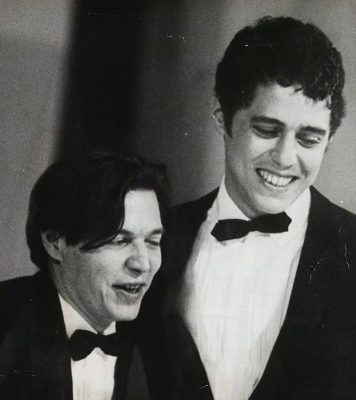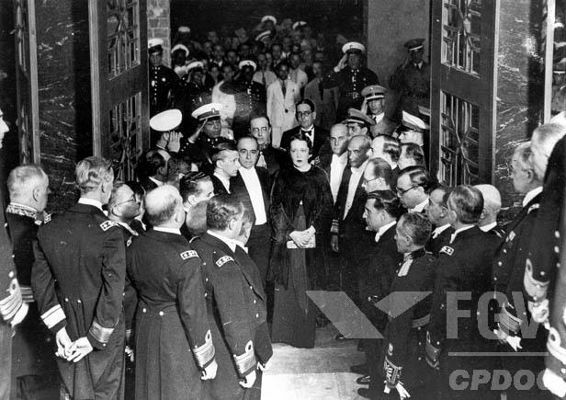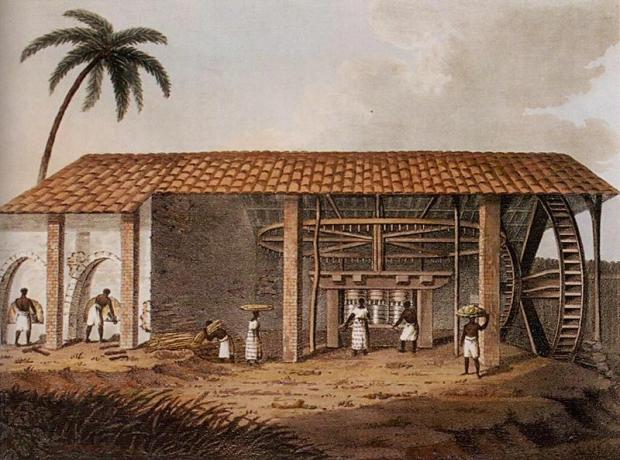One of the Brazilian artists who had the greatest projection abroad, Tom Jobim he was a conductor, musician, singer, pianist and composer who, above all, liked to praise his country and his hometown in his songs, Rio de Janeiro.
Some consider him the greatest genius of Brazilian music. His works helped to Popular Brazilian Music (MPB) to become known around the world in the 60s. One of the greatest composers of the 20th century, Tom Jobim, together with the poet Vinicius de Moraes, is the author of the most famous Brazilian music in history, the "Girl from Ipanema".
Read too: The life and work of Chico Buarque
Life
Antônio Carlos Brasileiro de Almeida Jobim was born on January 27, 1927, in a house located on Rua Conde de Bonfim, in the Tijuca neighborhood, in the North Zone of Rio de Janeiro. The musician was born in his home, in a birth performed by the same person who brought the samba composer and composer Santa Rosa to the world, as revealed in the book “Antonio Carlos Jobim, a man illuminated”, by Helena Jobim.
Tom Jobim was the son of diplomat Jorge de Oliveira Jobim and Nilza Brasileiro de Almeida. He only had one sister, Helena. At less than a year old, Tom Jobim's family moved to the neighborhood of Ipanema, in the South Zone. The musician has always loved the joy, the bohemia and the carioca's way of being.
Do not stop now... There's more after the advertising ;)
Throughout his career, Tom Jobim paid homage, through his songs, to his neighborhood Ipanema, his state, Rio de Janeiro, and his country, Brazil.
Although he was called Antonio, few called him that. Most knew him as Tom or Tom Tom, nickname given by his sister, Helena, who, as a child, did not know how to pronounce his name. Jobim grew up among artists and the bohemian carioca scene. From a young age, he became interested in music, influenced by his uncles who played instruments.
At 14, the conductor had his first piano lessons with the German composer Hans Joachim Koellreutter, who taught at Colégio Brasileiro de Almeida, whose owner was his mother, Nilza. Tom also played guitar and flute. The musician even studied the course of Architecture and Urbanism, but abandoned him to dedicate himself to music, his great passion.
![Statue of Tom Jobim in the neighborhood of Ipanema (RJ) [2]](/f/bae03d837f1b5613afe3111c28b57879.jpg)
Statue of Tom Jobim in the neighborhood of Ipanema (RJ). [2]
In 1949, at age 22, he married Thereza de Otero Hermanny, with whom he had two children, Paulo and Elizabeth. They broke up in 1978. Ana Beatriz Otter she was Tom Jobim's second wife and who stayed with him until the end of his life. He married her in 1986. Together, they had children João Francisco and Maria Luiza.
The musician kept a house in the Rio neighborhood gardenBotanical and a place in PitBackground (RJ). Furthermore, since the 1960s Jobim has spent much of his life in NewYork (USA), city he loved. His apartment was located near Central Park.
See too: The biography of Toquinho, an important name in MPB
→ New York
According to interviews, the composer said that he liked the North American city because, when he was in it, he didn't need to prove anything. He also claimed to like the skyscrapers of the place.
The conductor also gave an interview, commenting that he liked to dedicate himself to animals, arts and nature. He was concerned with destruction, with the fires of the Amazon, with the Indians, among others.
Tom Jobim also stated that, being far from his country, he had a different point of view, a consciousnessbiggergivesyourhomeland. He started to miss him more and maybe that's why he wrote more things about Brazilian roots.
→ Tom Jobim's death
Tom Jobim died from a stopcardiac, on December 8, 1994, aged 67, at Mount Sinai Hospital, which was near his New York apartment. Jobim's death caused a great commotion not only in Brazil, but in the world. The wake was held at Jardim Botânico, in Rio de Janeiro.
Work by Tom Jobim
Composer, musician, pianist and owner of a smooth and harmonious voice, Tom Jobim is dubbed by many as conductor and genius of Brazilian Popular Music (MPB). In his musical career, he was influenced by chopin, in Debussy and especially from Hector Villa-Lobos.
During his artistic life, Jobim composed on three themes most frequently: love, nature, especially Brazilian fauna and flora, and Rio de Janeiro. In his works, he also liked to talk about Brazil and its customs.
→ Start
As a musician, in the 40s and early 50s, Tom Jobim played the piano in bars and nightclubs in the neighborhoods of Copacabana and Ipanema, nicknamed by himself as “hells”. At the same time, he studied orchestration, harmony and composition.
In 1952, the Brazilian was hired by the Continental label. Tom Jobim's first great musical success was a samba-canção entitled “Tereza from the beach”, in 1954.
→ Top songs by Tom Jobim
“Chega de saudade” (1958)
"Corcovado" (1960)
“Samba from the plane” (1962)
“Only dance samba” (1962)
"Wave" (1967)
“March Waters” (1973)
"Lígia" (1973)
“One Note Samba” (1974)
Partnerships
Tom Jobim's career was marked by numerous successful partners. Among its national partners, we can mention:
Astrud Gilberto;
Baden Powell;
Billy Blanco;
Dolores Duran;
Elis Regina;
Eliseth Cardoso;
Flora Purim;
Gal Costa;
Joao Gilberto;
Newton Mendonça;
Sergio Mendes;
Silvinha Teles, among others.
Among the international partnerships, those established with Stan Getz, Charlie Byrd, Frank Sinatra, Ella Fitzgerald, among other names in the pop and Jazz.

→ Partnership with Vinícius de Moraes
Unquestionably, Tom Jobim's most famous partnership was with the poet ViníCius de Moraes. According to the composer himself, it was a fruitful and very gratifying partnership, one of the most important in MPB.
In the mid-1950s, Moraes was looking for someone to make the music for play "Orfeu da Conceição". Jobim was chosen. Thus began their long partnership, which was also taken to their personal lives. Together, they composed more than 50 songs.
Know more: Carmen Miranda: an important Brazilian celebrity
The play “Orfeu da Conceição” was released in 1956, at the Municipal Theater of Rio de Janeiro. Jobim orchestrated, conducted and composed part of a musical score. The song was part of the play “If everyone were like you” – one of the duo's biggest hits.
The piece became the movie "Black Orpheus", which, in 1959, won the Oscar for best foreign film. He was also awarded the Palme d'Or at the Cannes Film Festival in France.
Check out some songs from the partnership between Tom Jobim and Vinícius de Moraes:
"Watercolor"
"No more missing"
"Last Spring"
"I do not exist without you"
"I know I will love you"
"Speaking of love"
"Foolishness"
"Girl from Ipanema"
"All my life"
"If everyone were like you"
“Girl from Ipanema"
Although Jobim and Moraes have made several musical partnerships, “Girl from Ipanema" is the best known of all. Research indicates that this song, known worldwide, is so successful until today, because it talks about simple things in life and people empathize with it.
In an interview with a radio station in the late 70s, Tom Jobim said that the episode narrated in the song “Girl from Ipanema”, the most famous of his career, really happened.
Jobim recalled that, in the early 1960s, in Ipanema, there really was a girlexceptionallypretty. While he and his friends had a beer at the Veloso bar, the girl passed by on her way to the sea and everyone stopped to see her, because the girl “was full of grace”.
The composer created some sketches of the song's lyrics and showed them to his friend Vinícius de Moraes, who also gave some hints. Thus, in 1962, the song “Girl from Ipanema” was born. In 1965, Jobim said that the girl who inspired the song was real and was 18 at the time. She is called Helô Pinheiro and even today has status of celebrity.
recordings

is called Helo Pinheiro. [4]
The song was first played on August 2, 1962, in a small nightclub in Copacabana. However, the singer Pery Ribeiro he was the first artist to record the song in the same year.
In 1963, Jobim created a instrumental version for the song and inserted it in his first American production called “O composer desafinado”.
“Girl from Ipanema” was performed in English by Astrud Gilberto, in March 1963, in the famous Carnegie Hall concert hall, in NewYork. Jazz saxophonist Stan Getz also performed the song for five minutes.
According to studies, in 1967, the American singer FrankSinatra he called Jobim and asked him to record “Girl from Ipanema”. With that, the music became known worldwide, causing the explosion of Bossa nova In the USA.
In 1964, “Girl from Ipanema” won four awardsGrammy.
The song was recorded by various artists around the world, such as Ella Fitzgerald, Madonna, Cher, Amy Winehouse. Some foreign artists usually play the song in their shows to pay homage to Brazil and Brazilians.
The song Garota de Ipanema was the first that gave Tom Jobim great projection abroad
Research indicates that the song “Girl from Ipanema” was recorded over 200 times around the world. United States, Germany and Japan are some of the countries where recordings were made. There is a legend that says that “Girl from Ipanema” was the second most played song in the 20th century, just behind the Beatles song “Yesterday”.
Thanks to this song, the small bar where Tom Jobim and Vinicius de Moraes would gather to watch the “girl pass” changed its name from bar Veloso to Bar e Restaurante Garota de Ipanema.
Read too: Michael Jackson: life, career and death
Tom Jobim's Curiosities
The song “Chega de Saudade”, from 1957, is considered the milestone of the birth of Bossa Nova. It was performed by João Gilberto.
In 1960, Jobim composed “Brasília, Sinfonia da Alvorada”, in honor of the then new Brazilian capital.
Tom Jobim released his first solo album (“The Composer of Desafinado Plays”), in 1963, in New York.
Tom Jobim even asked the poet Carlos Drummond de Andrade for a rhyming dictionary.
In 1968, Jobim and Chico Buarque won the 3rd International Song Festival with the song “You knew”. Despite the award, both received boos from the audience, who preferred the song “Para Não Dizer que Não Falei de Flores”, by Geraldo Vandré.
The conductor composed soundtracks for national films such as “Sea Time", 1970; “I love you", 1981; “Gabriela", 1983; and "To live a great love", 1983.
In 1984, Tom Jobim founded Banda Nova, with which he toured to various countries and which he was part of until the end of his life.
Tribute
Rio de Janeiro International Airport, also known as Galeão, was renamed on January 5, 1999, Antonio Carlos Jobim Airport in honor of the musician. The plaque contains the following words: “Homage of the Brazilian nation to conductor Antônio Carlos Jobim, who knew how to sing about the beauty of the wonderful city.”
Image credits:
[1] Credit: Morning mail / Wikimedia Commons
[2] Credit: André Luiz Moreira / Shutterstock
[3] Credit: National Archives / Wikimedia Commons
[4] Credit: Personal Archive
By Silvia Tancredi
Journalist



